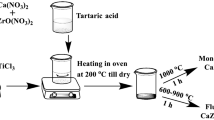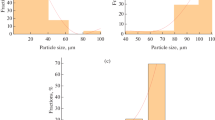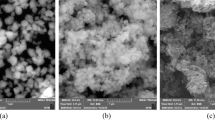Abstract
The engineering of doped zirconia nanoparticles (NPs) for energy application is realized in concept Research Smart Laboratory. To improve nanomaterials’ engineering, correlations of “salt concentration—powder dispersity” and “calcined temperature—particle’s sizes” were built. The correlation of “materials structure—materials functionality” is made. The technology forming ceramics with varying grain sizes and densities under the same thermodynamic conditions (1350 °C) from NPs with different sizes is developed. The impedance spectroscopy with the distribution of relaxation time analysis is used for ionic conductivity ceramic investigation in range 240–900 °C. The activation energies of the grain and grain boundary oxygen diffusion are calculated. It was shown that the energy activation of bulk oxygen diffusion does not depend on ceramic grain size (Ea = 0.9 eV). The energies activation of grain boundary oxygen diffusion estimated in the framework of the bricklayer model show a weak growth with the rising of ceramic grains sizes. The values of the volume activation energy are close to the grain-boundary activation energy for ceramics obtained from nanoparticles smaller than 18 nm. It was found that the grain boundary space contains two types of elements with different geometries. The size of NPs used for ceramic determines the size of grain boundaries elements. It was shown that the density of sintered ceramic has a more substantial effect on its electrophysical properties than grain size. The NPs sizes of 18–24 nm are optimal for forming pressed powder compacts and sintered ceramics with high density.











Similar content being viewed by others
Abbreviations
- CPE:
-
Constant phase element
- C g, C gb1, C gb2 :
-
Capacity of grain and grain boundary spaces
- DRS:
-
Distribution of relaxation time analysis
- E a :
-
Energy activation
- gb1, gb2:
-
Grain boundary spaces
- NPs:
-
Nanoparticles
- R :
-
Resistor
- S sa :
-
Specific surface area
- S msa :
-
External and mesoporous specific surface area
- SEM:
-
Scanning electron microscopy
- SOFC:
-
Solid oxide fuel cell
- T cal :
-
Calcined temperature
- U max :
-
Maximum of voltage
References
Global Energy Transformation: A roadmap to 2050, International Renewable Energy Agency, Abu Dhabi. www.irena.org/publications (2019).
Salameh, Z.: Renewable Energy System Design. Academic Press, San Diego (2014) https://doi.org/10.1016/B978-0-12-374991-8.00001-5
Hussan, S.; Yanping, L.: Review of solid oxide fuel cell materials: cathode, anode and electrolyte. Energy Trans. 4, 113–126 (2020). https://doi.org/10.1007/s41825-020-00029-8
Zeng, J.; Xu, Y.; Yu, J.; Zhang, X., et al.: Compact yttria-stabilized zirconia based total NOx sensor with a dual functional Co3O4/NiO sensing electrode. ACS Sens. 4, 2150–2155 (2019). https://doi.org/10.1021/acssensors.9b00981
Shylo, A.; Doroshkevich, A.; Lyubchyk, A.; Bacherikov, Yu., et al.: Electrophysical properties of hydrated porous dispersed system based on zirconia nanopowders. Appl. Nanosci. 10, 4395–4402 (2020). https://doi.org/10.1007/s13204-020-01471-2
Precious-Ayanwale, A.; Donohué-Cornejo, A.; Cuevas-González, J.C.; Espinosa-Cristóbal, L.F., et al.: Review of the synthesis, characterization and application of zirconia mixed metal oxide nanoparticles. Int. J. Res. Granthaalayah. 6, 136–145 (2018). https://doi.org/10.5281/zenodo.1403844
Kogut, I.; Wollbrink, A.; Wulfmeier, H.; El Azzouzi, F.-E., et al.: Linking the electrical conductivity and non-stoichiometry of thin film Ce1−xZrxO2−δ by a resonant nanobalance approach. Materials (Basel). 14(4), 748 (2021). https://doi.org/10.3390/ma14040748
Stub, S.; Vollestad, E.; Norby, T.: Protonic surface conduction controlled by space charge of intersecting grain boundaries in porous ceramics. J. Mater. Chem. 6, 8265–8827 (2018). https://doi.org/10.1039/c7ta11088j
Novoselov, I.; Karengin, A.; Shamanin, I.; Alyukov, E.; Gusev, A.: Plasmachemical synthesis of nanopowders of yttria and zirconia from dispersed water-salt-organic mixtures. AIP Conf. Proc. 1938, 020010 (2018). https://doi.org/10.1063/1.5027217
Vasylkiv, O.; Sakka, Y.: Synthesis and sintering of zirconia nano-powder by non-isothermal decomposition from hydroxide. J. Ceram. Soc. JAPAN 109, 500–505 (2001). https://doi.org/10.2109/jcersj.109.1270_500
Tsuzuki, T.: Mechanochemical synthesis of metal oxide nanoparticles. Commun. Chem. 4(143), 1–11 (2021). https://doi.org/10.1038/s42004-021-00582-3
Dahiya, M.S.; Tomer, U.K.; Duhan, S.: Metal–ferrite nanocomposites for targeted drug delivery. In: Asiri, A.M.; Inamudin, D.; Mohammad, A. (Eds.) Applications of nanocomposite materials in drug delivery, pp. 737–760. Woodhead Publishing, Berlin (2018). https://doi.org/10.1016/B978-0-12-813741-3.00032-7
Zirconia. Tosoh corporation, Tokyo. https://www.rbhltd.com/wp-content/uploads/2019/05/Tosoh-Zirconia-Brochure.pdf (2019)
Leib, E.W.; Pasquarelli, R.M.; Blankenburg, M.; Muller, M.; Schreyer, A., et al.: High-temperature stable zirconia particles doped with yttrium, lanthanum, and gadolinium. Part. Part. Syst. Charact. 33, 645–655 (2016). https://doi.org/10.1002/ppsc.201600069
Charitidis, C.A.; Georgiou, P.; Koklioti, M.A.: Manufacturing nanomaterials: from research to industry. Manuf. Rev. 1(11), 1–19 (2014). https://doi.org/10.1051/mfreview/2014009
Phan, H.T.; Haes, A.J.: What does nanoparticle stability mean? J. Phys. Chem. C Nanometer Interfaces 123(27), 16495–16507 (2019). https://doi.org/10.1021/acs.jpcc.9b00913
Jeong, Y.-S.; Chin, S.H.: Synthesis and characterization of high surface area of Zirconia: effect of pH. Korean Chem. Eng. Res. 57, 133–141 (2019). https://doi.org/10.9713/kcer.2019.57.1.133
Huang, Z.; Han, W.; Feng, Z.; Qi, J.; Wu, D., et al.: The effects of precipitants on coprecipitation synthesis of yttria-stabilized zirconia nanocrystalline powders. J. Sol Gel Sci. Technol. 90, 359–368 (2019). https://doi.org/10.1007/s10971-019-04947-y
Jang, W.; Yun, J.; Ludwig, L.; Jang, S.G.; Bae, J.Y., et al.: Comparative catalytic properties of supported and encapsulated gold nanoparticles in homocoupling reactions. Front. Chem. 8(834), 1–9 (2020). https://doi.org/10.3389/fchem.2020.00834
León, B.; Albano, M.P.; Stábile, F.M.; Garrido, L.B.: Processing of concentrated aqueous zirconia-bioglass slips by slip casting. Ceramics-Silikáty 61(2), 91–98 (2017). https://doi.org/10.13168/cs.2017.0002
Kim, H.J.; Kim, M.; Neoh, K.C., et al.: Slurry spin coating of thin film yttria stabilized zirconia/gadolinia doped ceria bi-layer electrolytes for solid oxide fuel cells. J. Power Sources 327, 401–407 (2016). https://doi.org/10.1016/j.jpowsour.2016.07.080
Obal, K.; Wyrwa, J.; Kruk, A.; Dziubaniuk, M., et al.: Microstructure and electrical conductivity of 3Y-TZP/Al2O3 composites. Process. Appl. Ceram. 15, 19–31 (2021). https://doi.org/10.2298/PAC21010190
Mahato, N.; Banerjee, A.; Gupta, A.; Omar, S.; Balani, K.: Progress in material selection for solid oxide fuel cell technology: a review. Prog. Mater. Sci. 72, 141–337 (2015). https://doi.org/10.1016/j.pmatsci.2015.01.001
Daza, P.C.C.; Meneses, R.A.M.; Ferreira, J.L.A.: Influence of microstructural characteristics on ionic conductivity of ceria based ceramic solid electrolytes. Ceram. Int. 44, 2138–2145 (2018). https://doi.org/10.1016/j.ceramint.2017.10.166
Xue, Q.; Huang, X.; Zhang, J.; Zhang, H.; Feng, Z.: Grain boundary segregation and its influences on ionic conduction properties of scandia doped zirconia electrolytes. J. Rare Earth 37, 645–651 (2019). https://doi.org/10.1016/j.jre.2018.11.006
Cheikh, A.; Madani, A.; Touati, A.; Boussetta, H.; Monty, C.: Ionic conductivity of zirconia based ceramics from single crystals to nanostructured polycrystals. J. Eur. Ceram. Soc. 21, 1837–1841 (2001). https://doi.org/10.1016/S0955-2219(01)00126-1
Priya, S.D.; Selvakumar, A.I.; Nesaraj, A.S.: Overview on ceramic and nanostructured materials for solid oxide fuel cells (SOFCs) working at different temperatures. J. Electrochem. Sci. Tech. 11, 99–116 (2020). https://doi.org/10.33961/jecst.2019.00612
Arena, A.; Prete, F.; Rambaldi, E.; Bignozzi, M.C.; Monaco, C., et al.: Nanostructured zirconia-based ceramics and composites in dentistry: a state-of-the-art review. Nanomaterials (Basel). 10(9), 1393 (2019). https://doi.org/10.3390/nano9101393
Tao, J.; Dong, A.; Wang, J.: The influence of microstructure and grain boundary on the electrical properties of scandia stabilized zirconia. Mater. Trans. 54, 825–832 (2013). https://doi.org/10.2320/matertrans.M2012385
Durá, O.J.; López de laTorre, M.A.; Vázquez, L., et al.: Ionic conductivity of nanocrystalline yttria-stabilized zirconia: grain boundary and size effects. Phys. Rev. B. 81, 184301 (2010). https://doi.org/10.1103/PhysRevB.81.184301
Vikrant, K.S.N.; García, R.E.: Charged grain boundary transitions in ionic ceramics for energy applications. npj Comput. Mater. 5, 24 (2019). https://doi.org/10.1038/s41524-019-0159-2
Hwang, J.H.; Mclachlan, D.S.; Mason, T.O.: Brick layer model analysis of nanoscale-to-microscale cerium dioxide. J. Electroceram. 3, 7–16 (1999). https://doi.org/10.1023/A:1009998114205
Maca, K.; Trunek, M.: Compaction and pressureless sintering of zirconia nanoparticles. J. Am. Ceram. Soc. 90, 2735–2740 (2007). https://doi.org/10.1111/j.1551-2916.2007.01781.x
Abdullah, B.J.; Jiang, Q.; Omar, M.S.: Effects of size on mass density and its influence on mechanical and thermal properties of ZrO2 nanoparticles in different structures. Bull. Mater. Sci. 39, 1295–1302 (2016). https://doi.org/10.1007/s12034-016-1244-5
Ghosh, A.; Dey, G.K.; Suri, A.K.: Correlation of electrical conductivity with microstructure in 3Y-TZP System: From nano to submicrometer grain size range. J. Am. Ceram. Soc. 91(11), 3768–3770 (2008). https://doi.org/10.1111/j.1551-2916.2008.02696.x
Dura, O.J.; De la Torre, L.; Chaboy, V.J.; Boada, R., et al.: Ionic conductivity of nanocrystalline yttria-stabilized zirconia: grain boundary and size effects. Phys. Rev. B 81, 184301 (2010). https://doi.org/10.1103/PhysRevB.81.184301
Kazlauskas, S.; Kazakevičius, E.; Zalga, A.; Daugėla, S.; Kežionis, A.: Peculiarities of charge carrier relaxation in grain boundary of gadolinium-doped ceria ceramics. Lith. J. Phys. 59, 94–103 (2019)
Miyoshi, S.; Akao, Y.; Kuwata, N.; Kawamura, J.; Oyama, Y., et al.: Low-temperature protonic conduction based on surface protonics: an example of nano-structured yttria-doped zirconia. Chem. Mater. 26, 5194–5200 (2014). https://doi.org/10.1021/cm5012923
Doroshkevich, A.S.; Asgerov, E.B.; Shylo, A.V.; Lyubchyk, A.I., et al.: Direct conversion of the water adsorption energy to electricity on the surface of zirconia nanoparticles. Appl. Nanosci. 9, 1603–1609 (2019). https://doi.org/10.1007/s13204-019-00979-6
Sun, Z.; Wen, X.; Wang, L.; Ji, D.; Qin, X., et al.: Emerging design principles, materials, and applications for moisture-enabled electric generation. eScience (2022). https://doi.org/10.1016//j.esci2021.12.009
Huang, Y.; Cheng, H.; Yang, C.; Zhang, P.; Liao, Q., et al.: Interface-mediated hygroelectric generator with an output voltage approaching 1.5 volts. Nat. Commun. 9, 4166 (2018). https://doi.org/10.1038/s41467-018-06633-z
Danilenko, I.; Gorban, O.; Shylo, A.; Volkova, G., et al.: Humidity to electricity converter based on oxide nanoparticles. J. Mater. Sci. (2022). https://doi.org/10.1007/s.10853-021-06657-9
Shylo, A.; Danilenko, I.; Gorban, O.; Doroshkevich, O., et al.: Hydrated zirconia nanoparticles as media for electrical charge accumulation. J. Nanopart. Res. 24, 18 (2022). https://doi.org/10.1007/s11051-022-05407-5
Konstantinova, T.; Danilenko, I.; Glazunova, V.; Volkova, G.; Gorban, O.: Mesoscopic phenomena in oxide nanoparticles systems: processes of growth. J. Nanopart. Res. 13, 4015–4023 (2011). https://doi.org/10.1007/s11051-011-0329-8
Gorban, O.; Synyakina, S.; Volkova, G.; Kulik, Y.; Konstantinova, T.: Surface influence on the behavior of stabilized zirconia nanoparticles under pressure. High Press. Res. 32, 72–80 (2012). https://doi.org/10.1080/08957959.2012.655245
Azhar, O.; Jahan, Z.; Sher, F.; Niazi, M.B.K., et al.: Cellulose acetate-polyvinyl alcohol blend hemodialysis membranes integrated with dialysis performance and high biocompatibility. Mater. Sci. Eng. C. 126, 112–127 (2021). https://doi.org/10.1016/j.msec.2021.112127
Sani, E.; Mercatelli, L.; Sans, J.-L.; Sciti, D.: Optical properties of black and white ZrO2 for solar receiver applications. Solar Energy Mater. Solar Cells 140, 477–482 (2015). https://doi.org/10.1016/j.solmat.2015.02.007
Al-Rawi, U.A.; Sherb, F.; Hazafa, A.; Bilala, M., et al.: Synthesis of Zeolite supported bimetallic catalyst and application in n-hexane hydro-isomerization using supercritical CO2. J. Environ. Chem. Eng. 9(4), 105206 (2021). https://doi.org/10.1016/j.jece.2021.105206
Frey, J.G.: Dark lab or smart lab: the challenges for 21st century laboratory software. Org. Proc. Res. Dev. 8, 1024–1035 (2004). https://doi.org/10.1021/op049895g
Brunauer, S.; Emmett, P.H.; Teller, E.: Adsorption of gases in multimolecular layers. J. Am. Chem. Soc. 60(2), 309–319 (1938). https://doi.org/10.1021/ja01269a023
Galarneau, A.; Mehlhorn, D.; Guenneau, F.; Coasne, B., et al.: Specific surface area determination for microporous/mesoporous materials: the case of mesoporous FAU-Y zeolites. Langmuir, ACS. 34(47), 14134–14142 (2018). https://doi.org/10.1021/acs.langmuir.8b02144.hal-01938089f
Geffert, A.; Geffertova, J.; Dudiak, M.: Direct method of measuring the pH value of wood. Forests 10(1–9), 852 (2019). https://doi.org/10.3390/f10100852
Plohl, O.; Zemljic, L.F.; Potrc, S.; Luxbacher, T.: Applicability of electro-osmotic flow for the analysis of the surface zeta potential. RSC Adv. 10, 6777–6789 (2020). https://doi.org/10.1039/C9RA10414C
Ivers-Tiffee, E.; Weber, A.: Evaluation of electrochemical impedance spectra by the distribution of relaxation times. J. Ceram. Soc. Jpn. 125, 193–201 (2017). https://doi.org/10.2109/jcersj2.16267
Ciuccia, F.; Chena, C.: Analysis of electrochemical impedance spectroscopy data using the distribution of relaxation times: a Bayesian and hierarchical Bayesian approach. Electrochim. Acta 167, 439–454 (2015). https://doi.org/10.1016/j.electacta.2015.03.123
Barsoukov, E.; Macdonald, J.R.: Impedance Spectroscopy. Theory. Experiment and Application. Wiley-Interscience, New York (2005) https://doi.org/10.1002/9781119381860
Schlupp, M.V.F.; Scherrer, B.; Ma, H.; Grolig, J.G., et al.: Influence of microstructure on the cross-plane oxygen ion conductivity of yttria stabilized zirconia thin films. Phys. Status Solidi A. 209, 1–9 (2012). https://doi.org/10.1002/pssa.201228248
Dietz, J.: Enterprise Ontology—Theory and Methodology. Springer, Berlin (2006) https://doi.org/10.1007/3-540-33149-2
Krishna Sarenda, M.; Annapoorani, S.; Ansar, E.B.; Harikrishna Varma, P.R., et al.: Magnetic hydtoremia studies on water-soluble polyacrylic acid-coated cobalt ferrite nanoparticles. J. Nanopart. Res. 16, 2773 (2014). https://doi.org/10.1007/s11051-014-2773-8
Pilipenko, N.P.; Konstantinova, T.E.; Tokiy, V.V.; Danilenko, I.A., et al.: Peculiarities of zirconium hydroxide microwave drying process. Funct. Mater. 2, 545–548 (2002)
Gorban, O.A.; Synyakina, S.A.; Kulik, Yu.O.; Ryumshina, T.A., et al.: Structural evolution of the ZrO2–Y2O3 nanoparticulate xerogels under high hydrostatic pressure. Funct. Mater. 17(40), 1–6 (2010)
Ivanov, V.K.; Baranchikov, A.Y.; Kopitsa, G.P.; Lermontov, S.A.; Yurkova, L.L., et al.: pH control of the structure, composition, and catalytic activity of sulfated zirconia. J. Solid State Chem. 198, 496–505 (2013). https://doi.org/10.1016/j.jssc.2012.11.022
Tao, K.; Dou, H.; Sun, K.: Interfacial coprecipitation to prepare magnetite nanoparticles: concentration and temperature dependence. Colloids Surf. A Physicochem. Eng. Asp. 320, 115–122 (2008). https://doi.org/10.1016/j.colsurfa.2008.01.051
Galarneau, A.; Villemot, F.; Rodriguez, J.; Fajula, F.; Coasne, B.: Validity of the t-plot method to assess microporosity in hierarchical micro/mesoporous materials. Langmuir 30, 13266–13274 (2014). https://doi.org/10.1021/la5026679|
Wohlleben, W.; Mielke, J.; Bianchin, A.; Ghanem, A., et al.: Reliable nanomaterial classification of powders using the volume-specific surface area method. J. Nanopart. Res. 19, 61 (2017). https://doi.org/10.1007/s11051-017-3741-x
Green, M.C.; Taylor, R.; Moeser, G.D.; Kyrlidis, A.; Sawka, R.M.: Mesoporous carbon black and processes making same. Patent USA, US 2009/0208751 A1 Aug. 20 (2009)
Sinelnikova, S.; Volkova, G.; Gorban, O.: Influence of dopant amount on evolution of zirconia crystal energy. Non-equilibrium phase transformations. Int. Sci. J. Mater. Sci. 1, 7–10 (2016)
Sameut-Bouhaik, I.; Leroy, P.; Ollivier, P.; Azaroual, M.; Mercury, L.: Influence of surface conductivity on the apparent zeta potential of TiO2 nanoparticles: application to the modeling of their aggregation kinetics. J. Colloid Interface Sci. 406, 75–85 (2013). https://doi.org/10.1016/j.jcis.2013.05.034
Muccillo, R.; Muccillo, E.N.S.: Electric field assisted sintering of electroceramics and in situ analysis by impedance spectroscopy. J. Electroceram. 38, 24–42 (2017). https://doi.org/10.1007/s10832-016-0054-x
Yavarinasab, A.; Janfaza, S.; Tahmooressi, H.; Ghazi, M., et al.: A selective polypyrrole-based sub-ppm impedimetric sensor for the detection of dissolved hydrogen sulfide and ammonia in a mixture. J. Hazard Mater. 416, 125892 (2021). https://doi.org/10.1016/j.jhazmat.2021.125892
Kežionis, A.; Kazlauskas, S.; Petrulionis, D.; Orliukas, A.F.: Relationship between charge carrier relaxation and peculiarities of electric response in some solid oxygen ion conductors. Solid State Ion. 279, 25–31 (2015). https://doi.org/10.1016/j.ssi.2015.07.009
Yavarinasab, A.; Janfaza, S.; Tasnim, N.; Tahmooressi, H., et al.: Graphene/poly (methyl methacrylate) electrochemical impedancetransduced chemiresistor for detection of volatile organic compounds in aqueous medium. Anal. Chim. Acta 1109, 27–36 (2020). https://doi.org/10.1016/j.aca.2020.02.065
McNealy, B.E.; Hertz, J.L.: On the use of the constant phase element to understand variation in grain boundary properties. Solid State Ionics 256, 52–60 (2014). https://doi.org/10.1016/j.ssi.2013.12.030
Kusnezof, M.; Wagner, D.; Schilm, J.; Heubner, C., et al.: Influence of microstructure and crystalline phases on impedance spectra of sodium conducting glass ceramics produced from glass powder. J. Solid State Electrochem. 26, 375–388 (2022). https://doi.org/10.1007/s10008-021-05063-0
Osinkin, D.; Antonova, A.; Lesnichyova, A.; Tropin, E.: Application of promising electrode materials in contact with a thin-layer ZrO2-based supporting electrolyte for solid oxide fuel cells. Energies 13(5), 1190 (2020). https://doi.org/10.3390/en13051190
Deportes, C.; Duclot, M.; Fabry, P.; Fouletier, J., et al.: Electrochimie des Solides. Grenoble Sciences, Grenoble (2008) https://doi.org/10.1051/978-2-7598-1216-5
Irvine, J.T.S.; Sinclair, D.C.; West, A.R.: Electroceramics: characterization by impedance spectroscopy. J. Adv. Mater. 2(3), 138–192 (1990). https://doi.org/10.1002/adma.19900020304
Kleitz, M.; Dessemond, L.; Steil, M.C.: Model for ion-blocking at internal interfaces in zirconias. Solid State Ion. 75, 107–115 (1995). https://doi.org/10.1016/j.pmatsci.2005.07.001
Guo, X.; Waizer, R.: Electrical properties of the grain boundaries of oxygen ion conductors: acceptor-doped zirconia and ceria. Prog. Mater. Sci. 51, 151–210 (2006). https://doi.org/10.1016/j.pmatsci.2005.07.001
Kilo, M.; Argirusis, C.; Borchardt, G.; Jackson, R.A.: Oxygen diffusion in yttria stabilized zirconia—experimental results and molecular dynamics calculations. Phys. Chem. Chem. Phys. 5, 2219–2224 (2003). https://doi.org/10.1039/b300151m
Acknowledgements
The authors are thankful the H2020-MSCA-RISE-2019 Program, project 871284 SSHARE for partial support of this work.
Author information
Authors and Affiliations
Corresponding author
Ethics declarations
Conflict of interest
The author declare that they have no conflict of interest.
Rights and permissions
About this article
Cite this article
Gorban, A., Shylo, A., Dmitrenko, V. et al. Zirconia-Based Nanomaterials for Alternative Energy Application: Concept of Research in Smart Laboratory. Arab J Sci Eng 48, 8453–8469 (2023). https://doi.org/10.1007/s13369-022-06976-2
Received:
Accepted:
Published:
Issue Date:
DOI: https://doi.org/10.1007/s13369-022-06976-2




